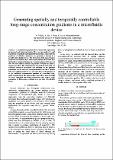Generating spatially and temporally controllable long-range concentration gradients in a microfluidic device
Author(s)
Vidula, Mahesh K.; Du, Y.; Shim, J.; Lo, E.; Khademhosseini, Ali
DownloadVidula-2009-Generating spatially and temporally controllable long-range concentration gradients in a microfluidic device.pdf (1.925Mb)
PUBLISHER_POLICY
Publisher Policy
Article is made available in accordance with the publisher's policy and may be subject to US copyright law. Please refer to the publisher's site for terms of use.
Terms of use
Metadata
Show full item recordAbstract
Concentration gradients have important applications in chemical and biological studies. Here we have achieved rapid generation of spatially and temporally controllable concentration gradients of diffusible molecules (i.e. proteins or toxins) in a portable microfluidic device. The formation of the concentration gradients was initiated by a passive-pump-induced forward flow and further optimized during an evaporation-induced backward flow. We were able to stabilize the gradient for up to 12 hours by stopping the flow. The computational simulations illustrated the combined effects of convection and diffusion on the gradient generation, and fit well with the experimental data. HL-1 cardiac cells were cultured in the device, and were shown to be responsive to the stabilized concentration gradient of a cardiac toxin, alpha-cypermethrin. The approach presented here may be useful for many biological and chemical processes that require rapid generation of long-range gradients in a portable microfluidic device.
Date issued
2009-05Department
Harvard University--MIT Division of Health Sciences and TechnologyJournal
Proceedings of the 2009 IEEE 35th Annual Northeast Bioengineering Conference
Publisher
Institute of Electrical and Electronics Engineers (IEEE)
Citation
Vidula, M. et al. “Generating Spatially and Temporally Controllable Long-range Concentration Gradients in a Microfluidic Device.” IEEE, 2009. 1–2. © 2009 IEEE
Version: Final published version
ISBN
978-1-4244-4364-2
978-1-4244-4362-8